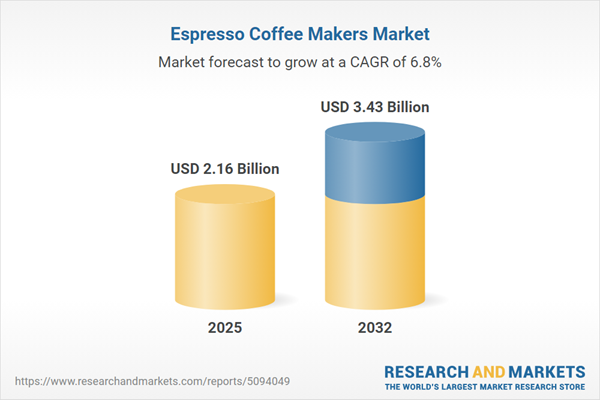Speak directly to the analyst to clarify any post sales queries you may have.
The espresso coffee makers market is evolving rapidly as organizations align procurement with operational goals, sustainability initiatives, and emerging technologies. Senior executives face increasing pressure to adapt sourcing and investment strategies in response to changing regulatory landscapes and performance expectations.
Market Snapshot: Espresso Coffee Makers Market Size and Growth
The espresso coffee makers market is experiencing steady growth, driven by sustained demand among both businesses and private consumers. Organizations are increasingly seeking equipment that ensures robust performance and enhances experiences for employees and guests. Manufacturers are responding to these needs with innovations such as digital capabilities, modular product architectures, and enhanced automation features. These developments support higher workflow efficiency and consistent beverage standards. The competitive market environment prioritizes reliability and continuous uptime, which remain critical for operational productivity in diverse commercial and residential settings.
Scope & Segmentation: Espresso Coffee Makers Market
- Machine Types: Senior decision-makers can choose between manual, semi-automatic, automatic, and super-automatic machines to achieve the preferred level of user input and process automation, directly impacting operational efficiency and beverage consistency.
- Pod and Coffee Input Variations: Available input types include single-use capsules, reusable capsules, ESE pods, soft pods, and standard ground coffee. These options enable organizations to meet user preferences while advancing sustainability and waste reduction goals.
- End-Users: Key customers encompass hotels, cafés, offices, and residential spaces. These buyers require products that deliver intuitive operation and reliability for everyday beverage service.
- Distribution Channels: Procurement is facilitated through online marketplaces, specialty retailers, traditional distributors, and supermarket supply chains, providing flexible replenishment strategies tailored to organizational priorities.
- Regional Coverage: The espresso coffee makers market serves the Americas, Europe, Middle East & Africa, and Asia-Pacific. Each region confronts unique regulatory requirements, technology adoption trends, and supply chain complexities, necessitating targeted procurement and compliance approaches.
- Segment Relevance: Demand for IoT-enabled and super-automatic models is growing as enterprises pursue digital transformation. The focus is also on machines compatible with recyclable pods and sustainability technologies, aligning with evolving environmental mandates across various industries.
Key Takeaways for Senior Decision-Makers
- Investing in digitally enabled espresso machines raises beverage quality, supports workplace satisfaction, and streamlines service standards across various locations.
- Automated systems help unify beverage preparation workflows, supporting consistent product quality while reducing labor and process complexity in multi-site operations.
- Prioritizing energy-efficient equipment and recyclable components helps organizations align with tightening environmental policies and strengthens corporate social responsibility initiatives.
- Expanding sourcing strategies—by leveraging diverse channels and establishing strong supplier partnerships—bolsters resilience amid fluctuating market and regulatory conditions.
- Access to comprehensive after-sales support, including remote diagnostics and proactive maintenance, maximizes asset life and minimizes downtime in high-usage environments.
- Seamless integration of advanced equipment with digital connectivity enables ongoing performance tracking and operational optimization for long-term value realization.
Tariff Impact and Industry Response
Recent changes in U.S. tariffs affecting espresso coffee makers and their components have prompted procurement professionals to refine sourcing and pricing strategies. Manufacturers are mitigating volatility by increasing regional assembly, diversifying supplier bases, and localizing production. Procurement teams enhance supply chain continuity and compliance by negotiating flexible agreements and reinforcing supplier oversight to adapt to evolving market conditions.
Methodology & Data Sources
This report draws from interviews with industry executives, trade association analyses, exclusive industry data, and global trade figures. Insights from end-user experiences and macroeconomic evaluation further inform strategic recommendations aimed at procurement and operational leaders in the espresso coffee makers market.
Why This Report Matters
- Senior executives and sourcing professionals gain access to focused insights on digital transformation, regulatory compliance, and best practices for procurement optimization.
- Real-time market intelligence elucidates the impact of technological and regional shifts, supporting adaptation and compliance in dynamic operating environments.
- Practical guidance helps drive process improvements and return-on-investment from deploying new or upgraded espresso equipment across organizational footprints.
Conclusion
Robust market intelligence empowers procurement and leadership teams to refine sourcing approaches, anticipate sectoral shifts, and unlock additional value within the evolving espresso coffee makers market.
Additional Product Information:
- Purchase of this report includes 1 year online access with quarterly updates.
- This report can be updated on request. Please contact our Customer Experience team using the Ask a Question widget on our website.
Table of Contents
3. Executive Summary
4. Market Overview
7. Cumulative Impact of Artificial Intelligence 2025
Companies Mentioned
The companies profiled in this Espresso Coffee Makers market report include:- Nestlé S.A.
- De'Longhi S.p.A.
- Keurig Dr Pepper Inc.
- Breville Group Limited
- Hamilton Beach Brands, Inc.
- Groupe SEB S.A.
- Koninklijke Philips N.V.
- Jura Elektroapparate AG
- Rancilio Group S.p.A.
- La Marzocco S.r.l.
Table Information
| Report Attribute | Details |
|---|---|
| No. of Pages | 198 |
| Published | October 2025 |
| Forecast Period | 2025 - 2032 |
| Estimated Market Value ( USD | $ 2.16 Billion |
| Forecasted Market Value ( USD | $ 3.43 Billion |
| Compound Annual Growth Rate | 6.8% |
| Regions Covered | Global |
| No. of Companies Mentioned | 11 |









